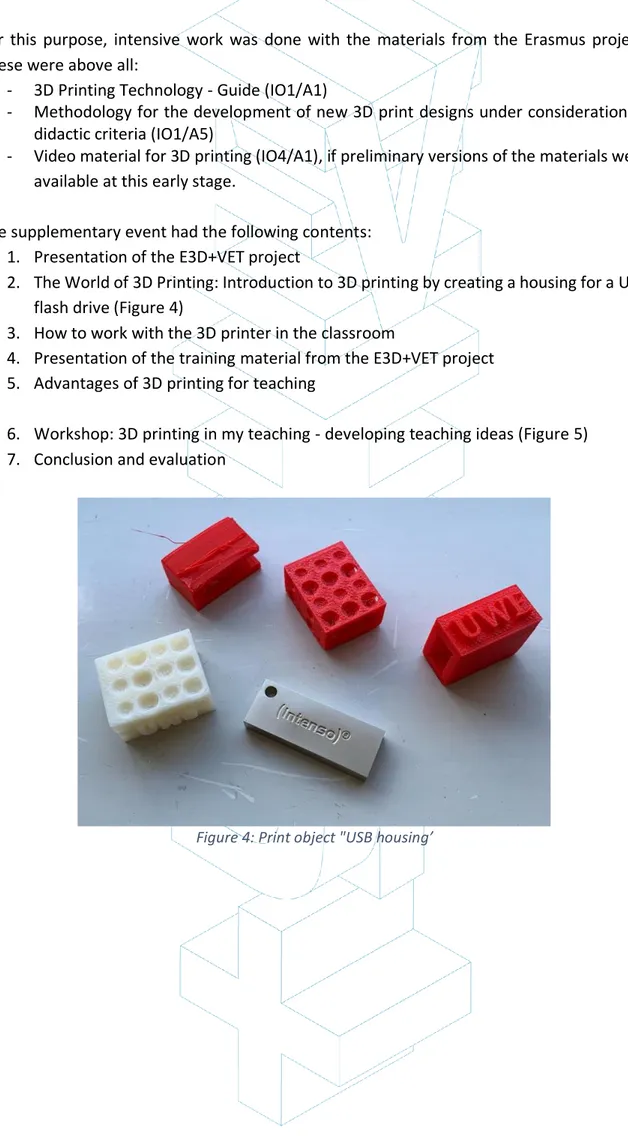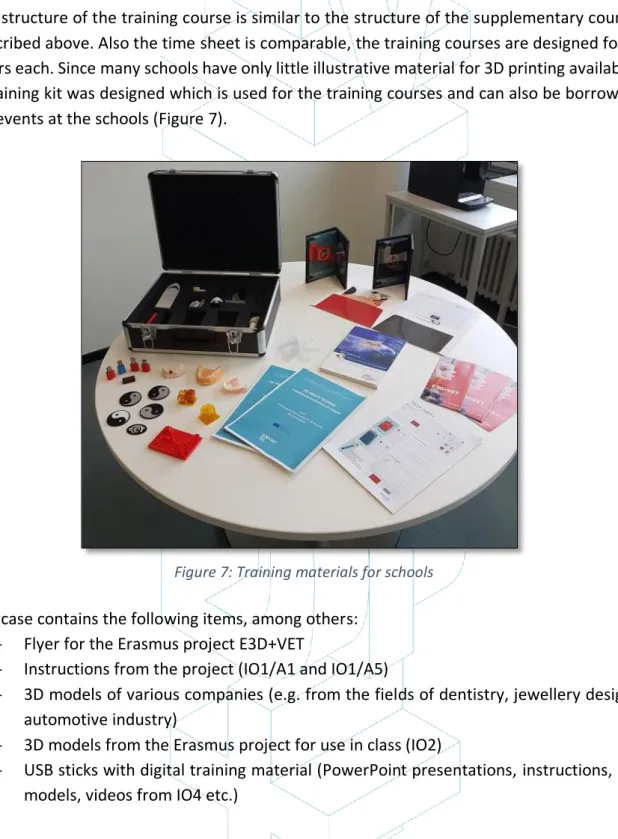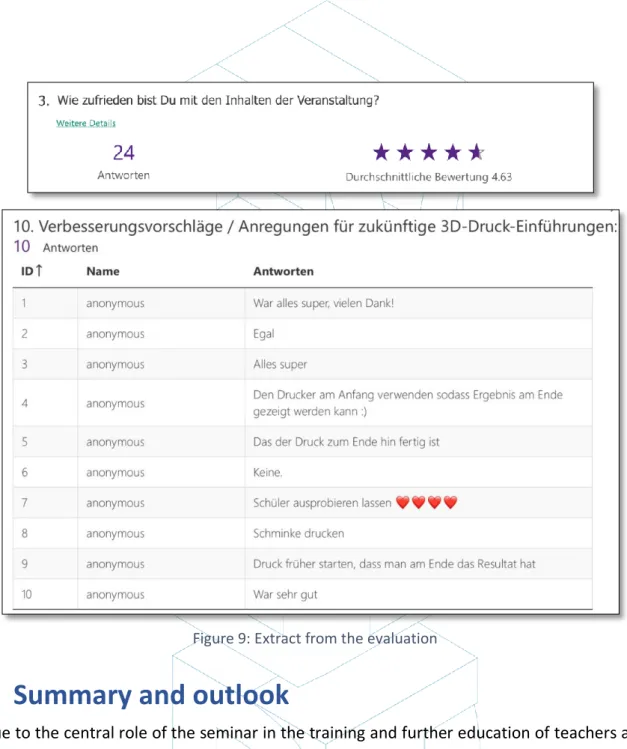IO 4 - Report and tools for the immersion of 3D printing in
European education and training
- O4A5 -
Validation and recognition of the
project results
ERASMUS3D+
For the immersion in 3D printing of VET centres.
project agreement number
2017-1-EN02-KA202-004159
This work is licensed under a
Creative Commons Attribution 4.0 International License
PARTICIPANT ORGANIZATIONS
Disclaimer:
"The European Commission support for the production of this publication does not constitute an endorsement of the contents which reflects the views only of the authors, and the Commission cannot be held responsible for any use which may be made of the information contained therein."
Table of contents
1 INTRODUCTION ...4
1.1 WHO WE ARE ...4
1.2 ORIGIN AND DEVELOPMENT OF THE PROJECT ...4
2 TRAINING OF TEACHERS AT THE SEMINAR ...5
2.1 ORGANISATION AND STRUCTURE OF THE TRAINING ...5
2.2 STRUCTURE AND CONTENT OF THE SUPPLEMENTARY COURSE "3D PRINTING FOR NON-TECHNICIAN TEACHERS” ...6
3 FURTHER TRAINING OF TEACHERS IN SCHOOLS...9
4 OFFERS FOR SCHOOL CLASSES ... 10
1 Introduction
1.1 Who we are
The Seminar für Ausbildung und Fortbildung der Lehrkräfte Karlsruhe (Berufliche Schulen) is a state authority of the state of Baden-Württemberg. It is responsible for the training of teachers for vocational schools in the area of North Baden (Figure 1). Due to a restructuring of the educational and further educational system in Baden-Württemberg, the task of further education of teachers has been added in 2019 for SEMKA.
Figure 1: Regierungsbezirk Karlsruhe (TUBS, CC BY-SA 3.0)
1.2 Origin and development of the project
By joining the Erasmus project E3D+VET, SEMKA has systematically worked with the innovative technology of 3D printing for the first time. A group of SEMKA colleagues - together with the other project partners from Germany, Spain, Italy and Slovenia - first of all developed a methodology of how teaching with the use of 3D printing technology can look like. The basis for this was the "3D Printing - Technical Guide"
(https://www.e3dplusvet.eu/wp-content/docs/O1A1-EN.pdf), which presents the technology of 3D printing in detail for teachers without previous knowledge in 3D printing. Based on this, a methodology was developed on how teachers can create exercises using 3D printing technology (https://www.e3dplusvet.eu/wp-content/docs/O1A5-EN.pdf). This
methodology is also a practical guide for teachers and serves as an example for the development of exercises that can be integrated into the platform (https://app.e3dplusvet.eu) and thus shared with the community of teachers. A special focus is placed on showing interested teachers the advantages of 3D printing compared to "normal" teaching.
In the next step, SEMKA established contact with schools that participated in the project. Several teachers were trained by SEMKA by using the materials developed by the consortium (Output 1). These teachers then developed exercises for their lessons, that were incorporated into the project (Output 2). Very quickly, a great deal of enthusiasm for the project became apparent. One reason for this was that many vocational schools in Baden-Württemberg had purchased 3D printers, but there was a lack of ideas on how these could be used in and for teaching. The following schools were involved in the project:
- Ludwig-Erhard-Schule Karlsruhe (http://www.les-ka.de)
- Carl-Hofer-Schule Karlsruhe (https://www.carl-hofer-schule.de) - Goldschmiedeschule mit Uhrmacherschule Pforzheim
(https://goldschmiedeschule.de)
- Schloss-Schule-Ilvesheim (https://schloss-schule-ilvesheim.de)
The exercises were technically implemented and printed by CETEM and KIT, because at that time no 3D printer was available at SEMKA. The printed models were then sent to the schools so that they could be reviewed and used for the lesssons. In Output 4 CEIPES and SEMKA have tested and evaluated the exercises, training materials and the platform in detail. A description of these tests pilots can be found on the project website. All models developed by SEMKA and its partners are available on the project platform (https://app.e3dplusvet.eu).
2 Training of teachers at the seminar
2.1 Organisation and structure of the training
In Germany, the training of teachers took place in two phases. Phase 1 is the study at a university. A master's degree is the prerequisite for entering phase 2. This phase 2 takes place at a state seminar (e.g. SEMKA), parallel to which training takes place at a school (Figure 2).
Figure 2: Basic structure of the training
During the project, SEMKA developed a plan for integrating 3D printing into teacher training in Baden-Württemberg. As the structure of the training is determined by the Ministry of Education, the formal possibilities are limited. However, in addition to the legally stipulated contents of the training, there are freely selectable courses in so-called "supplementary courses". Here, a course was developed in which trainers from SEMKA present the possibilities of 3D printing and develop ideas for their own lessons together with the instructors (Figure 3).
Figure 3: Course programme
2.2 Structure and content of the supplementary course "3D printing
for non-technician teachers”
The supplementary event was first offered on 28 June 2019. The aim was to familiarise trainees teaching in non-technical subjects in particular with the technology of 3D printing and to show them the possibilities this innovative technology offers for their work in schools.
For this purpose, intensive work was done with the materials from the Erasmus project. These were above all:
- 3D Printing Technology - Guide (IO1/A1)
- Methodology for the development of new 3D print designs under consideration of didactic criteria (IO1/A5)
- Video material for 3D printing (IO4/A1), if preliminary versions of the materials were available at this early stage.
The supplementary event had the following contents: 1. Presentation of the E3D+VET project
2. The World of 3D Printing: Introduction to 3D printing by creating a housing for a USB flash drive (Figure 4)
3. How to work with the 3D printer in the classroom
4. Presentation of the training material from the E3D+VET project 5. Advantages of 3D printing for teaching
6. Workshop: 3D printing in my teaching - developing teaching ideas (Figure 5) 7. Conclusion and evaluation
Figure 5: Trainee teachers during the workshop phase
The event had a total duration of 8 hours of 45 minutes each (9:00 am to 4:30 pm). The evaluation showed that this time was very well suited to introduce people without previous knowledge to the technology and to develop ideas for teaching together with them. Across disciplines, the trainee teachers developed ideas to make different topics more comprehensible for students using 3D printing. These ideas are then passed on to the training schools and thus have a great influence on teachers at these schools. The influence thus extends far beyond direct education.
The evaluation of the event showed very good results (Figure 6). The 15 participants were very satisfied with the supplementary course. They especially praised the fact that they were able to try out 3D printing in practice - from drawings on paper to the printed model. Based on these results, the event will continue to be offered regularly.
3 Further training of teachers in schools
In addition to the initial training of young teachers, SEMKA is also responsible for the further qualification of teachers in service. And here, too, SEMKA has developed events for further training. The teacher training courses are advertised online in Baden-Württemberg (https://lfb.kultus-bw.de/Startseite), so that all teachers from all over the state can register for them.
The structure of the training course is similar to the structure of the supplementary course described above. Also the time sheet is comparable, the training courses are designed for 8 hours each. Since many schools have only little illustrative material for 3D printing available, a training kit was designed which is used for the training courses and can also be borrowed for events at the schools (Figure 7).
Figure 7: Training materials for schools
The case contains the following items, among others: - Flyer for the Erasmus project E3D+VET
- Instructions from the project (IO1/A1 and IO1/A5)
- 3D models of various companies (e.g. from the fields of dentistry, jewellery design, automotive industry)
- 3D models from the Erasmus project for use in class (IO2)
- USB sticks with digital training material (PowerPoint presentations, instructions, 3D models, videos from IO4 etc.)
The case can thus also be used by teachers who have little or no previous experience with 3D printing. The instructions from the project provide them with excellent training material that provides a very good introduction to the subject. It is also possible to use the case for classroom use. Especially the 3D models from different professional contexts are very well suited to explain the importance of the topic to students at vocational schools.
The training courses and the 3D case were presented and promoted at several multiplier events by SEMKA:
- Presentation at the conference "WES 4.0 - Mobile Learning with the Tablet" on 19.10.2018
- Presentation at a service meeting with all trainers and staff of the seminar on 30.09.2019
- Presentation at the trade fair "LearnTec" on 29.01.2020
- Presentation at events with school principals from North Baden on 13.02.2020
4 Offers for school classes
In addition to the actual tasks of SEMKA – training and further education of teachers – several classes have already received direct training. Since this is not the actual task of SEMKA, the work with students is only possible in a limited time frame after consultation with the seminar leadership.
The events take place either directly at the schools or on the premises of the seminar. In both cases, the materials from the project (especially the instructions from IO1) and the 3D case descriped above can be used. Schools that have not yet purchased a 3D printer can use the seminar equipment. For this purpose, a 3D printing laboratory has been newly set up, which is available for school classes but of course also for the staff of the seminar. Two 3D printers (Ultimaker S3 and FlashForge Finder) are available in this lab. The instruction in the use of the laboratory is carried out by a member of the seminar staff.
Figure 8: School class during training
In the past months, a total of four events with school classes took place. There is also no restriction to specific subject areas. For example, classes from the nursing, technology and design sectors were introduced to 3D printing (Figure 8). The concept for these events was evaluated by SEMKA and adapted according to the feedback. Overall, the feedback was very good, and the possibilities for improvement were more related to smaller details (see extracts in Figure 9).
Figure 9: Extract from the evaluation
5 Summary and outlook
Due to the central role of the seminar in the training and further education of teachers and the close connection to vocational schools, the influence of the project on the state of Baden-Württemberg is enormous. In addition to the initial training of teachers, further training takes place both on the premises of the seminar and directly at the schools. The close interlocking of trainers with schools continues to guarantee the direct training of students of all subject areas (Figure 10).
Figure 10: Areas of qualification
The seminar also plays a central role as a multiplier. All employees of the seminar are simultaneously working at one or more schools in Baden-Württemberg. In this way, the topics presented and discussed at the seminar are spread out. With regard to 3D printing, this means that the project results and the training and further education developed within the project can be made known at all vocational schools in the North Baden area. Thus, the
project reaches a total of about 300 vocational school centres with 20,500 teachers and 350,000 students.
All the events developed under the project (supplementary events for teacher training, further training and training courses for school classes) have now become regular operations and will thus be continued in the following years. In this way, the E3D+VET project was able to contribute to the didactic reflection and profitable use of 3D printing in schools in Baden-Württemberg.






